2-Stroke Oil Mix Guide | How to Mix, Chart & Free Calculator
How to Mix 2-Stroke Oil (The Right Way Every Time)
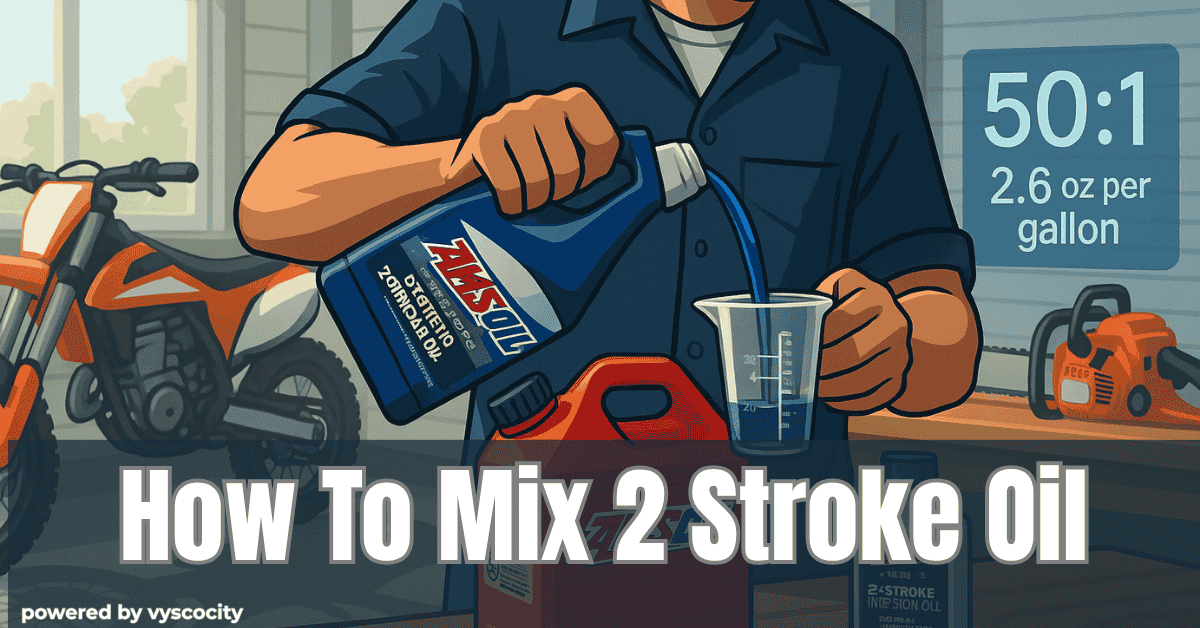
Knowing how to mix 2-stroke oil properly is critical for your chainsaw, dirt bike, or small engines — and doing it wrong can cost you an engine. Whether you're fueling a chainsaw, outboard motor, dirt bike, or leaf blower, using the right oil-to-gas ratio is non-negotiable.
Most importantly, we'll break down the most common mix ratios, show you how to do it properly, and give you access to a free calculator to make the job easier.
👉 Use the Vyscocity 2-Stroke Oil Mix Calculator
How to Mix 2-Stroke Oil – Step-by-Step
Mixing 2-stroke fuel is easy once you know the correct ratio and steps. Here's how to get it right every time:
-
Check the recommended ratio for your engine (most commonly 50:1 or 40:1).
-
Measure the gas using a clean fuel container — not your lawnmower's tank.
-
Use a graduated mixing cup or measuring device to pour the exact amount of oil.
-
Add the 2-stroke oil to the gas container first or after (just be consistent).
-
Seal and shake the container gently to fully mix the oil and fuel.
-
Label your container if storing premix, especially for different ratios.
💡 Pro tip: Use ethanol-free gas if possible — it burns cleaner and stores better.
❌ Common Mistakes to Avoid
Many small engines are ruined by bad mixes. Watch out for these errors:
-
Eyeballing the oil amount instead of measuring
-
Mixing directly in the equipment's tank
-
Using old, separated gas
-
Assuming all 2-stroke oils are the same
-
Guessing the ratio instead of checking the manual
Understanding Mix Ratios for Beginners
A 2-stroke mix ratio tells you how much oil to blend with gasoline. For example:
-
50:1 = 2.6 oz of oil per gallon of gas
-
40:1 = 3.2 oz per gallon
-
32:1 = 4 oz per gallon
In other words each engine is built for a specific mix. Too much oil can cause carbon buildup. Too little and your engine could seize.
When in doubt, 50:1 is the most common and safest for modern engines.
Can I Use Synthetic 2-Stroke Oil?
Yes — and you should. AMSOIL SABER® Professional is a high-performance synthetic 2-stroke oil trusted by mechanics and pros.
-
Works with all ratios, even 100:1
-
Low smoke and carbon
-
Extends engine life
-
Stabilizes fuel and cleans internal parts
👉 Buy AMSOIL SABER 2-Stroke Oil Now
Try Our Free 2-Stroke Mix Calculator
Instead of guessing, use the Vyscocity Mix Calculator to plug in:
-
Your desired ratio (50:1, 40:1, 32:1, etc.)
-
The amount of gas
-
And get the exact ounces of oil to use
Mobile-friendly. No ads. No fluff.
GAS OIL MIX RATIO CHART
PREMIX CHART| RATIO | OUNCES PER 1 GALLON | OUNCES PER 2.5 GALLON | OUNCES PER 5 GALLON | MILLILITER PER 1 LITER | MILLILITER PER 5 LITER | MILLILITER PER 10 LITER |
|---|---|---|---|---|---|---|
| 32:1 | 4 | 10 | 20 | 31 | 156 | 313 |
| 40:1 | 3.2 | 8 | 16 | 25 | 125 | 250 |
| 50:1 | 2.56 | 6.4 | 12.8 | 20 | 100 | 200 |
| 80:1 | 1.6 | 4 | 8 | 13 | 63 | 125 |
| 100:1 | 1.28 | 3.2 | 6.4 | 10 | 50 | 100 |
Why AMSOIL SABER® Professional Is the Best Choice
Not all oils are created equal. AMSOIL SABER® is specifically engineered for:
-
Clean-burning performance
-
High-heat protection in small engines
-
Minimal plug fouling and smoke
-
Long-term fuel storage
Ideal for chainsaws, weed eaters, dirt bikes, outboards, and ice augers — especially in commercial or high-use settings.
Why Proper 2-Stroke Mixing Matters — Real World Examples
A proper 2-stroke fuel mix isn't just technical — it directly affects how your tools perform in real-world conditions. A poorly mixed batch might run fine at first, but under pressure (like a hot day or long uphill climb), it could cause your engine to bog down, smoke excessively, or even seize.
For example:
-
Dirt bikes in hot terrain need clean-burning fuel to avoid plug fouling.
-
Chainsaws used at high altitudes benefit from richer, more stable mixes.
-
Outboard motors need synthetic oil to run clean at low idle speeds.
In extreme cold, proper mix ratios and synthetic oils ensure your engine starts easily and maintains lubrication, even in subzero temps.
If you're running machines in rugged environments, mix with care — and label your fuel. Saving a few seconds now could cost you a piston later.
Storing Mixed Fuel Safely
Once mixed, fuel should be stored in a properly labeled, sealed container:
-
Out of sunlight
-
Away from heat
-
Ideally used within 30–90 days
Add AMSOIL Quickshot® or a stabilizer to extend life and avoid gumming up your carburetor.
What If I Run Straight Gas in a 2-Stroke?
This is one of the fastest ways to destroy a 2-stroke engine.
Without oil:
-
Your piston will overheat
-
The cylinder will seize
-
You'll lose compression and likely wreck the engine
Even 5 seconds of running straight gas can cause permanent damage. Always double-check your mix.
How Fuel Quality Affects Your Mix
Even with the perfect oil ratio, poor gas quality can cause issues. Ethanol-blended gas absorbs moisture and breaks down quickly, especially in small tanks. That's why many pros use premium, ethanol-free gas for 2-stroke engines — it stays stable longer and burns cleaner. Adding a stabilizer like AMSOIL Quickshot® prevents phase separation and keeps fuel fresh for up to 90 days. If you're storing mixed gas for backup tools, storm season, or race weekends, always invest in good gas and airtight containers. A good mix starts with clean fuel and ends with a well-running machine.
FAQ | Schedule 1 Mixing & 2-Stroke Ratios
Answer: The most common is 50:1. With high-quality synthetic oils like AMSOIL SABER, 100:1 is safe for most air-cooled engines unless otherwise specified by the manufacturer.
Answer: Only if the oil is rated for it. SABER is engineered for 100:1 premix. Always check your engine manual first. It works best in air cooled engines
Answer: Canada's Schedule 1 guidelines encourage leaner, cleaner-burning mixes for environmental reasons. Using a calculator ensures you're compliant and accurate.
Answer: Too much oil can cause plug fouling, smoke, and carbon buildup. Too little oil can lead to engine seizure from poor lubrication.
2.6 ounces of oil per gallon of gas.
Yes — it contains more oil.
No — they're different systems. 4-strokes don't require premix.
Most use 50:1. With AMSOIL Saber you can safely go up to 100:1. Check your manual for confirmation.
Powered by Vyscocity
Even better this guide and calculator were built by Vyscocity to help riders, workers, and backyard mechanics mix fuel the right way.
Bookmark it. Share it. Save your engine.
2 Stroke Oil (2T)
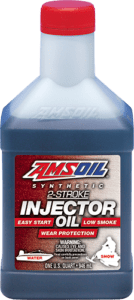
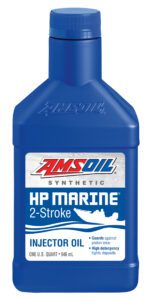
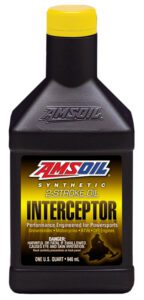
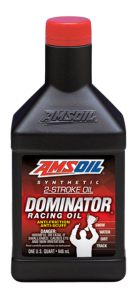
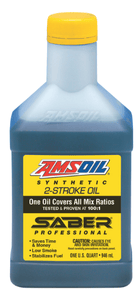
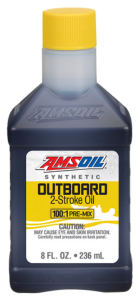
Where to Buy / Become a Dealer
Looking to buy AMSOIL?
Powered by Vyscocity
Built by Vyscocity to help you get the job done right — whether you're riding, wrenching, or running a fleet.
Explore our products, try our free tools, and let us know how it works for you.
❓ Still stuck? Ask your question on Facebook →
No fluff. Just function.










